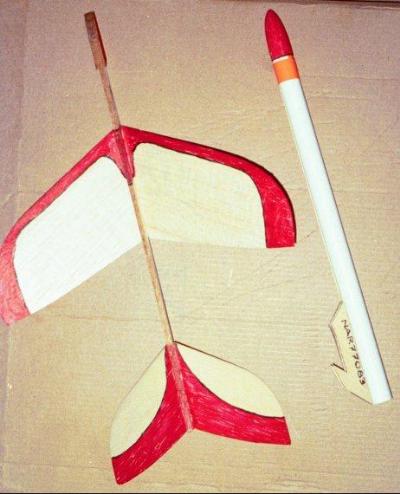| Manufacturer: | Contest Craft  |

(Contributed - by Kevin Johnson)
 Brief:
Brief:
Competition class boost glider with pop pod retrieved by a streamer.
Construction:
The Ivee 2G kit consists of a 13mm body tube, eleven (11) laser cut balsa
pieces, a balsa nose cone, a Kevlar® external shock cord, and a piece of tape.
The IVEE 2G is a joint venture kit between Edmonds Aerospace and Apogee. I ordered this kit from Apogee (through their catalog, it is not on their website) and it came in a bag with all parts and no breakage.
The instruction booklet was great, with lots of good illustrations and a lot of text explain the steps. Unlike every other kit I've gotten from Edmonds, you are instructed to sand an airfoil into the wings. There were templates for getting a good airfoil section included. You should have a sanding block with medium and fine grade sandpaper as well as yellow or white glue. This is a competition geared kit, and Rob Edmonds has taken the time to write directions that will walk you through some of the steps to make a winning model. There was a very detailed section on trimming and test flying in the directions.
This kit also differs from many of the other Edmonds offerings in that there is no jigsaw like construction, and there are some exacting measurements you have to follow to get the CG and wing/tail dihedral.
Other than that, construction is pretty straight forward for a boost glider type rocket: sand the wings and tail, glue them onto the boom and attach the side plates to act as a hook to engage the booster. The power pod goes together with equal ease: glue together the parts for its hook and attach to the body tube (the directions offer the suggestion to wrap a piece of sandpaper around the tube and sand a curve into the hook before gluing to get a smoother fit and better seams--- this is a competition kit after all). Glue the shock cord to the outside of tube along the BT hook joint, attach the top of the shock cord to the front of the BT by using the included tape. The nosecone is secured to the shock cord by using a small bead threaded onto the cord, then glued into a small hole in the cone. The streamer attaches to the cord with a bit of the supplied tape. Motor retention is by tape wrapped around the end of the BT after the motor is installed.
Finishing:
You probably want to save weight by not adding anything to this kit to finish
it, the bare balsa is light and looks sweet all on its own. To aid tracking I
did add some color with magic marker.
Construction Rating: 5 out of 5
Flight:
I didn't get a chance to flight test the IVEE before using it in a contest, so
I was a little nervous on the first flight. I loaded an A3-4T, checked in and
waited for the launch. A good straight boost with a little weathercocking into
the wind. Separation was good and the glider took off downwind. A great flight
of 63 seconds before the timers lost sight of the small glider. I found it a
1/4 to 1/2 mile downrange.
On the second flight I tried to beat the wind a little with an A10-3T and cocked the launch rod upwind to try and keep the glide over the launch area. The launch was up and into the wind, another good separation and a nice circling glide that again went quickly downrange. This flight was tracked to 96 seconds, but landed in a wheatfield and was quietly sacrificed to the agriculture gods.
Recovery:
The shock cord is Kevlar®, and mounted externally. You should probably add one
square of wadding rolled up in a ball to protect the paper streamer.
Flight Rating: 5 out of 5
Summary:
The IVEE 2G is a great competition kit. The instructions are clear and give
lots of information that you can use when working with other gliders.
Overall Rating: 5 out of 5
Sponsored Ads
 |
 |











